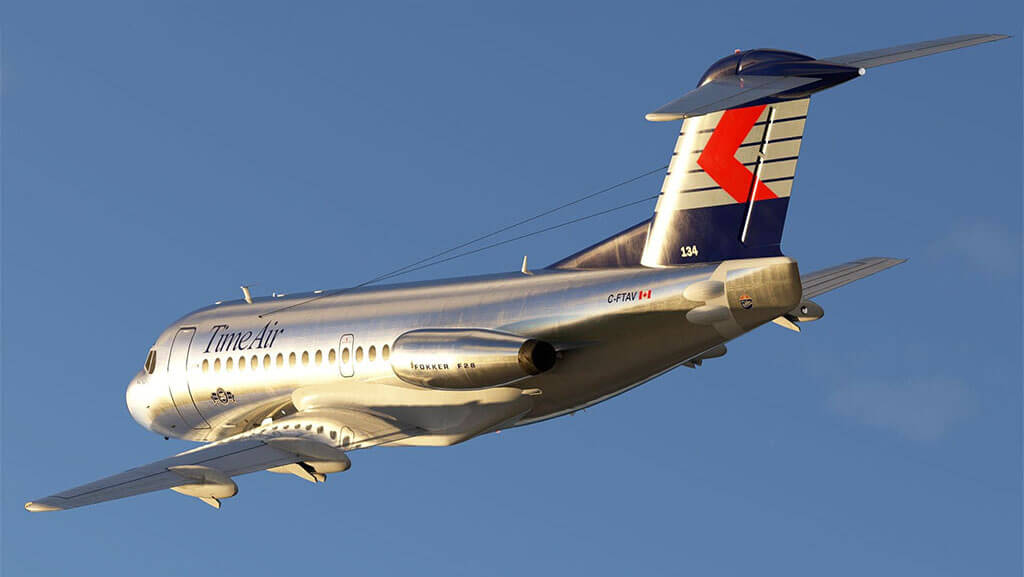Fokker F28

Photo Credit: Just Flight of the UK
Following the success of the Fokker F27 Friendship, Fokker decided to embark on developing a new turbojet-powered commuter aircraft that would build upon its experiences with the Fokker F27. During the design phase, a high level of attention was paid to market research and operator concerns. Amongst many changes made, the prospective jetliner was increased in size, changing its maximum seating capacity from 50 to 65 passengers. Fokker announced the formal launch of the Fokker F28 Fellowship in April 1962.
Design features of the aircraft
Featuring a T-tail and engines mounted at the rear of the fuselage, the Fokker F28 was equipped with wings that had a slight crescent angle of sweep. The wing was furnished with ailerons positioned near the tips, along with simplistic flaps that would be supplemented by the ailerons during landing approaches. All of the flight control surfaces were actuated via duplicated cabling and (except for the rudder) aerodynamically balanced. It was also fitted with a five-section lift-dumper that would only be operated after landing. It was decided to employ a lift-dumper rather than alternatives such as thrust reversers. The designers felt that this arrangement would result in a reduction in both weight and maintenance workload. Excluding the use of thrust reversers also meant that the chance of the engines ingesting debris was lessened when being operated upon unpaved airstrips. The wing also had a fixed leading edge and was deiced via bleed air drawn from the engines.
The Fokker F28 Fellowship had a retractable tricycle landing gear, which used large, low-pressure tires, enabling the use of unpaved airstrips. The use of antiskid brakes on the main wheels of the undercarriage also contributed to a shorter landing run.
The aircraft is powered by a pair of Rolls-Royce Spey turbojet engines; dependent on model, capable of generating up to 9,850 lbf (43.9 kN) of thrust. The movable split-sections installed on the tail cone could be hydraulically opened outwards to act as a variable air brake.
Technical Specifications
| Crew: | 2 Pilots – 2 Flight Attendants |
| Capacity: | 65 Passengers |
| Length: | 89 ft 10 in (27.4 m) |
| Wingspan: | 77 ft 4 in (23.6 m) |
| Height: | 27 ft 9.5 in (8.47 m) |
| Wing Area: | 822 sq ft (76.4 m2) |
| Empty Weight: | 35517 lb (16144 kg) |
| Max Takeoff Weight: | 65000 lb (29480 kg) |
| Fuel Capacity: | 2869 US Gal |
| Max Payload: | 18983 lbs (8629 kg) |
| Powerplant: | 2 × Rolls Royce Spey Mk 555-15 turbofan engines, 9850 lbf (43.9kN) each |
| Cruise speed: | 458 kts (606.526 mph, 848 km/h) at 20,000 ft (6096 m) |
| Range: | 920 nmi (2965.559 mi, 1705 km) |
| Service ceiling: | 35000 ft (10700 m) |
Aircraft Registration
| Registration | MSN |
| C-GTUU | 11006 |
| C-GTEO | 11991 |
| C-FTAS | 11098 |
| C-FJRI | 11103 |
| C-FCRK | 11087 |
| F-GBBX | 11027 |
| C-GNCR | 11034 |
| N465AU | 11064 |
| N466US | 11075 |
| C-GTAH | 11082 |
| C-FTAS | 11098 |
| N452US | 11105 |
| C-FTAV | 11106 |
